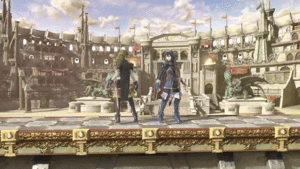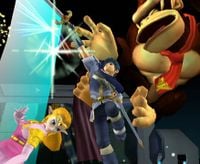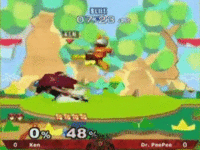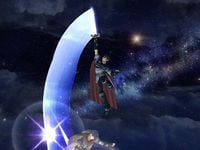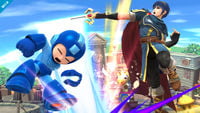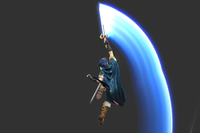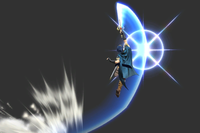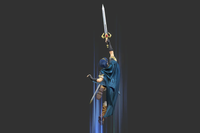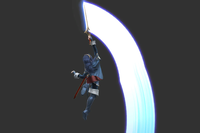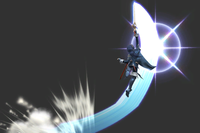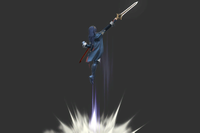Dolphin Slash
| Dolphin Slash | |
|---|---|
Dolphin Slash in Super Smash Bros. Ultimate. | |
| Users | Marth Lucina |
| Universe | Fire Emblem |
The Dolphin Slash (ドルフィンスラッシュ, Dolphin Slash) is Marth and Lucina's up special move.
Overview[edit]
The user slightly moves forward, quickly swipes their sword upward, and performs a high-spiraling leap, with their blade extended horizontally-to-vertically. The player can angle the move to either gain more horizontal distance or more vertical distance, and the player can also reverse the move, similarly to Super Jump Punch. Right before the user starts rising, the move has a fast (frame 5) and fairly powerful hitbox which either launches opponents horizontally or vertically, depending on how close the opponent is to the user. As the user is rising, the move has a much weaker hitbox which lasts for a short period of time. Once the user has finished their ascent, they will slowly stall in the air until they start falling, where they have very limited aerial mobility. It provides decent vertical recovery, but very little horizontal recovery, which overall makes it an exploitable recovery move, especially in earlier games. The move is quite effective as an attack however, due to its fast speed, respectable range, decent strength, and the fact that it provides some intangibility during its startup, which gives it a fair amount of utility in other areas. As well as being a recovery move, it can be used as an out of shield option (being the user's fastest OoS option), an escape tool, an edgeguarding tool or as a combo ender.
In Super Smash Bros. Melee[edit]
In Super Smash Bros. Melee, Dolphin Slash comes out on frame 5 and Marth is intangible during this one frame. At the tip of the sword, the move deals 13% and strong horizontal knockback (especially at lower percents) while at a closer range, the move only deals 10% and much weaker vertical knockback. The tipper does have the highest priority out of all the move's hitboxes though, which does make it easier to land than most of Marth's other tipper attacks. The sweetspot KOes Mario at around 80% at the edge of Final Destination and at around 130%-140% from the center without DI. After the move's first active frame, the move's hitboxes become drastically weaker, dealing 7% or 6% depending on where the move lands allowing with drastically weaker horizontal or vertical knockback. These hitboxes last until frame 12 and Marth can grab ledges starting from frame 23 of the animation.
Because of these factors, the move is best used as an attack when the opponent is in directly front of Marth. The move is a very effective attack due to its fast speed, long range and strong power which notably makes it effective as either an out of shield option or as a combo ender. The clean hit also cannot be directly challenged due to Marth being intangible, although the opponent can hit Marth before or after the hitbox comes out. The move is Marth's fastest Out of Shield option, being one frame faster than his grab (it is a frame 6 OoS option as Marth has to be in jumpsquat for one frame before he can use it). When combined with its strength, this can make it Marth's most desirable OoS option in some situations.
The main drawback the move has as an attack however it that it is extremely punishable. After jumping up, Marth stalls in the air for some time before he starts falling and when he starts falling, he has incredibly limited horizontal control. When used near the edge, Marth cannot drift to the edge to reduce the total lag and if he is facing the ledge and fails to reverse it, he will lose a stock. The move has a heafty 34 frames of landing lag which when combined with the previous points, gives the opponent a lot of time to punish Marth. This can often lead into a stock, even at very low percents as opponents can either charge a very powerful punish or begin a devastating combo. Marth can utilise platforms to make the move harder to punish, especially since he can quickly land on the top platform on tri-plat stages and the move can be edge canceled although both options are not always available, the former option is still very punishable while the latter is very difficult to perform.
As a recovery move, Dolphin Slash is rather subpar overall. While the move's hitboxes do make it risky to challenge and it does cover decent vertical distance, the move does not travel far horizontally at all and the move can very easily be edge hogged, due to its short duration. An edge roll consistently beats Dolphin Slash and Marth often cannot do anything to avoid it. The opponent can even use an angled light shield at the ledge to get hit by Dolphin Slash which will then make them slide off to grab the ledge. Marth's only real option is to land on stage but that puts him in a punishable amount of landing lag and he often cannot edge cancel the move in a recovery situation either.
Reverse Dolphin Slash[edit]
A "Reverse Dolphin Slash" can be performed by starting the attack and quickly moving the joystick backwards. This will cause Marth to turn around just before jumping upwards, with it occurring right after the move's clean hit. While this is naturally useful for recovering, Marth can also use it to hit opponents in front of him with the sweetspot and then turn around. This makes Dolphin Slash an effective edgeguarding tool as Marth can hit a recovering opponent with the sweetspot (which has high horizontal knockback) and then he can turn around to make it back to the stage. Marth can also use a reverse Dolphin Slash as a combo ender, being an alternative finish to a Ken Combo in situations where his down aerial is either impossible to land or too risky. This is particularly useful in the PAL version of the game, where down aerial's sweetspot was changed from a spike to a meteor smash.
While a reverse Dolphin Slash is effective at dealing with opponents in front of Marth, it is not particularly strong at dealing with opponents behind Marth. As the turnaround happens on frame 6, the move's hitboxes are much weaker once Marth turns around. Opponents have to be very close to Marth in order for him to hit them if they are directly behind him and it Marth does hit them, the move is highly punishable on hit right up until higher percents.
Overall, Dolphin Slash is a subpar recovery move but a high risk high reward attack with utility in numerous areas.
In Super Smash Bros. Brawl[edit]
In Super Smash Bros. Brawl, Dolphin Slash has seen numerous changes with the move being improved overall. In terms of recovery, the move has become less exploitable. Marth now moves forwards when using the move in the air, Marth can now grab ledges while rising with the move (if he is facing the ledge), Marth no longer loses his double jump if he is hit out of Dolphin Slash, Marth stays in the air for longer before falling and Marth has slightly more control over his trajectory as he falls. These changes overall improve Dolphin Slash's recovery potential, with the move being less susceptible to edge hogging. If the opponent performs a ledge option too fast, Marth can now potentially grab the ledge due to both the changes to edge hogging and the changes Dolphin Slash received. The increase to Marth's mobility after using the move also helps the move on stage as Marth can now drift to the edge when using it near the edge and if Marth uses it while facing away from the edge, he can now make it back to the edge or stage to prevent a guaranteed stock loss.
As an attack, the move has seen some improvements as well. The move has larger hitboxes, especially on its clean hit and the clean hit is now active for an extra frame, although the late hit still becomes active on frame 6 despite this. The clean hit's sourspot is much stronger, dealing more damage and knockback. It now has the same power as the tipper hitbox although it retains its vertical launch angle, which can make it KO earlier than the tipper hitbox depending on Marth's stage position. The clean hit's tipper hitbox is weaker however although it still has respectable KO power, KOing Mario at around 90% at the edge of final destination and 140% in the center.
Another notable improvement the move received is that the move is now intangible for the first five frames of its animation rather than only on the fifth frame. This gives the move more utility in a number of areas. First of all, it makes the move riskier to challenge as opponents can no longer hit Marth out of the move's startup.
Secondly, it improves the move's use as an Out of Shield option. The move can now be performed on the first frame of Marth's jumpsquat, making it a frame 5 option which along with its superior range, makes it a better punishment option Out of Shield. The addition frames of intangibility make Dolphin Slash a far better defensive option OoS as Marth can use it to escape and punish many multi-hits on shields (even when most other OoS options cannot), escape an opponent's grab OoS when his spot dodge cannot (which almost every other character cannot do OoS) or to simply avoid an opponent's attack while also punishing them. This makes Dolphin Slash a contender for the best Out of Shield option in the game as it is not only a very fast option with great range and solid KO power but these factors combined with its intangibility on startup makes it an incredible escape option which is only rivalled by Whirling Fortress. Its only real downside is that if the move misses, Marth is left wide open for a punish.
Thirdly, it makes the move very effective at escaping multi-hits, combos at lower percents and chain grabs. The move is risky to use for this purpose but if the move lands, it is very rewarding and the move's instant intangibility and long range allows it to avoid many moves/combos many other characters cannot avoid.
Reverse Dolphin Slash[edit]
Marth can still reverse his Dolphin Slash but Marth reverses the move earlier, with the reverse now occurring on frame 4 rather than frame 6. On the one hand, this allows Marth to hit opponents behind him with the sweetspot which benefits the move Out of Shield especially. Marth can also angle the move backwards more without reversing, which improves its mixup potential for recovering and when used on stage. On the other hand, this also makes Dolphin Slash worse for edgeguarding as it is drastically harder to hit opponents with the tipper hitbox when reversing the move. Marth can still use the move for edgeguarding if he hits opponents in front due to the improvements the move received but this is more limited than being able to hit the sweetspot and then reverse the move.
The move has seen one notable downside however. The move has one additional frame of landing lag and the move now suffers from RCO lag. This does not hurt the move too much as Marth has three safe, long ranged aerials with low landing lag and Marth is a floatier character, making it harder for his opponent to force him into a landing after an attack but it still negatively impacts the move overall. The move can also no longer be edge canceled due to the removal of universal edge canceling on normal/special landings which also negatively impacts the move.
Overall, Dolphin Slash is a better recovery move and a more versatile attack. While the sweetspot has lower KO potential and the move has a bit more landing lag, the sourspot is much stronger, the move has more range and more intangibility which all make the move a more versatile and effective attack overall, in addition to being a less exploitable recovery tool.
In Super Smash Bros. 4[edit]
In Super Smash Bros. 4, Dolphin Slash has seen some changes with most of them hindering the move.
The move is largely the same in terms of recovering, although it does travel slightly less distance. On the flip side, the move notably benefits from the removal of edge hogging which makes it a much more reliable recovery tool overall, despite its overall shorter distance. The move is harder to edgeguard and it can be difficult to two frame due to its disjointed hitbox. This means that Marth almost never has to mix up going for the ledge or landing on stage and if he does land on stage, the move now only has 20 frames of landing lag instead of 35 which makes it less punishable on landing. The move still suffers from RCO lag although Marth only gets 30 frames of landing lag from a hard landing instead of 35, and the move is also less susceptible to RCO due to the changes to the glitch.
As an attack however, the move has been toned down. The clean hit now only deals 11% and it deals less knockback, KOing around 10% later. The clean hit also has less range and it has more hitlag, with the former making the attack harder to land overall. The grounded version of the move also has less intangibility, with Marth now only being intangible on frames 4 and 5 rather than from frames 1-5. This makes the move easier to challenge when Marth is on the ground and it hinders the move's use as an Out of Shield option, especially when combined with its reduced power and range. It is no longer Marth's fastest escape option OoS which makes it much less useful against multi hit moves or against safe pressure from Marth's opponent. The aerial version however is still intangible from frames 1-5 so it can still be used as a strong escape option in the air.
With Lucina being added as a clone of Marth, she also possesses her own version of Dolphin Slash. Her version gains slightly less height than Marth’s, which makes it worse for recovering (although this is partially compensated by Lucina having a higher double jump than Marth).
In earlier versions of the game, Dolphin Slash was less effective. The clean hit dealt less knockback and the move had 23 frames of landing lag which made it less rewarding when it landed and more punishable when it missed. The clean hit KOed around 25%-27% later than its Brawl counterpart (depending on which hitbox landed). In version 1.0.8, the clean hit's knockback was increased, with the move KOing around 16% earlier although the clean hit also received slightly higher hitlag to somewhat compensate. In version 1.1.0, the move had 3 frames of landing lag cut off which made it slightly less punishable. These changes made Dolphin Slash more rewarding and less punishable, improving the move overall.
Overall, Dolphin Slash is a more effective recovery move but a less effective attack. While it is less punishable due to its lower landing lag, it has less power, range and the grounded version has less intangibility which all hinder the move's effectiveness and utility. The move also still remains highly punishable despite its lower landing lag. The move is still a strong Out of Shield option as the move retains its fast speed and it still has a solid amount of range and it is still a strong escape option in the air but it is still weaker in these areas due to the aforementioned factors. Nevertheless, it still remains a strong move with utility in multiple areas.
In Super Smash Bros. Ultimate[edit]
In Super Smash Bros. Ultimate, Dolphin Slash has updated visual effects where the move leaves multiple afterimages as the user leaps upward, similar to Fox Illusion. Lucina’s version also now grants just as much height as Marth’s version (rather than less), although Marth's version grants marginally less height (although still more than Lucina's version in the previous game). Apart from its updated visuals and its slight height differences (especially for Lucina's version), the only notable change the move received is that it has 4 more frames of landing lag which makes it more punishable.
Strangely, the move still suffers from RCO lag, unlike many other special moves which previously suffered from the glitch.
Overall, Dolphin Slash is largely the same move as it was in the previous game, except it is a bit more punishable when used on stage due to its higher landing lag. It is still a strong vertical recovery move, it is still a strong out-of-shield option, and it is still a strong escape option in the air.
Instructional quotes[edit]
| Marth's Dolphin Slash is fast and powerful, but it leaves him vulnerable upon landing. | ||
| Strike upward as you rise through the air. | ||
| Strikes upward as he rises into the air. Deals the most damage at the start. | ||
| Strikes upward as she rises into the air. Deals the most damage at the start. |
Customization[edit]
Special Move customization was added in Super Smash Bros. 4. These are the variations:
| 1. Dolphin Slash | 2. Crescent Slash | 3. Dolphin Jump |
|---|---|---|
| "Strike upward with your sword as you rise into the air. Deals most damage at the start." | "Rise in an arc while attacking. Deals most damage at the midpoint. Doesn't go as high." | "Jump really high, but you won't deal any damage." |
- Dolphin Slash: Default.
- Crescent Slash: Attacks at a steeper angle but with less height. Does most damage at the midway point. It notably grants Marth and Lucina followups in situations where they normally do not have any followups.
- Dolphin Jump: Jumps higher but it cannot hit opponents.
Origin[edit]
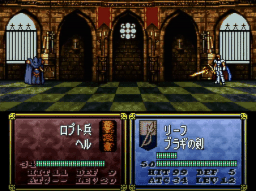
Although the move has not been named or seen in any of the Fire Emblem games, Dolphin Slash's animation loosely resembles the jumping portion of the critical hit animations of the lord class from Fire Emblem Geneology of the Holy War and Fire Emblem Thracia 776, which at the time of Melee were the latest releases in the series. This follows the trend of Fire Emblem's unique animations being given a name and ability in Super Smash Bros., such as Shield Breaker being based on Marth's standard attack animation, and Counter being based on the ability to strike back against enemies when attacked at all.
The name may be a reference to the Nintendo GameCube, the system on which the move debuted, as the console was codenamed "Dolphin".
Gallery[edit]
Dolphin Slash in Super Smash Bros. for Wii U.
Names in other languages[edit]
Trivia[edit]
- The sound effect of the Dolphin Slash varies from Melee to Brawl. In its first appearance, Marth grunts while the sword makes a very slight woosh sound. However, in Brawl, Marth is silent, and the sword now makes a very loud slash, almost akin to an explosion. In Smash 4, Dolphin Slash does a more typical slashing sound, louder than Melee but softer than Brawl.
- In SSB4 since version 1.0.8, and in Ultimate, Lucina occasionally grunts when using Dolphin Slash. Marth, however, does not.
- In Fire Emblem Warriors, Marth's Strong Attack includes a rising jump slash very similar to Dolphin Slash, though it is not named as such.

